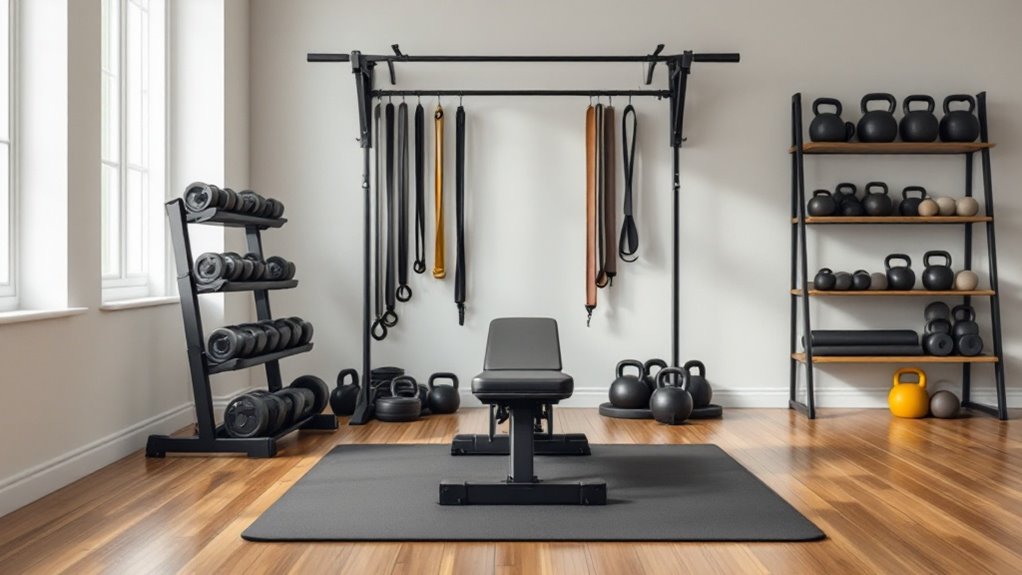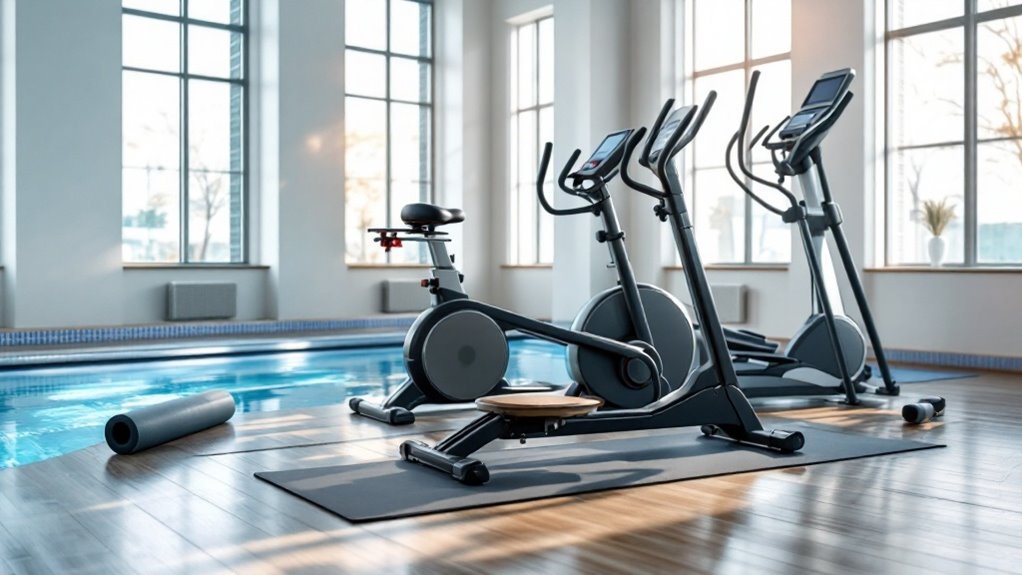Workouts for Men Over 50

Men over 50 can maintain strength and mobility through a balanced fitness program. The focus should be on compound movements like squats and deadlifts, performed with proper form and moderate weights. Low-impact cardio activities, including swimming and cycling, protect joints while building endurance. Recovery becomes essential, with 48-72 hours between strength sessions. Regular stretching and mobility work prevent injury. This foundational approach reveals sustainable fitness gains.
Key Takeaways
- Focus on low-impact exercises like swimming and cycling to maintain cardiovascular health while protecting joints from excessive stress.
- Start with bodyweight exercises to master proper form before progressing to weighted compound movements like squats and deadlifts.
- Include mobility work and stretching daily, particularly targeting hip flexors and shoulders to maintain flexibility and prevent injury.
- Allow longer recovery periods between workouts, typically 48-72 hours, and incorporate active recovery days with gentle movement.
- Begin with moderate intensity and gradually increase workout difficulty while monitoring sleep quality and recovery to prevent overtraining.
Essential Strength Training Exercises for Mature Men

Strength becomes the foundation of energy and independence for men over 50. Focusing on compound movements like squats, deadlifts, and bench presses builds functional power while maintaining joint health.
These exercises activate multiple muscle groups simultaneously, maximizing workout efficiency. Key exercises should target the major muscle groups: legs, back, chest, shoulders, and core.
Proper form takes precedence over heavy weights, preventing injury while building sustainable strength. Starting with bodyweight exercises allows mature men to establish correct movement patterns before progressing to resistance training.
Training frequency of 2-3 times per week provides adequate recovery time between sessions, essential for muscle repair and growth. Implementing progressive overload principles gradually increases workout intensity to ensure continuous strength gains while minimizing injury risk.
Low-Impact Cardio Options That Protect Your Joints

While building muscle remains essential, cardiovascular fitness demands equal attention for men over 50. Low-impact activities protect aging joints while maintaining heart health and endurance. Swimming, cycling, and elliptical training offer excellent alternatives to high-impact running.
| Activity | Benefits | Duration |
|---|---|---|
| Swimming | Full-body workout, zero impact | 30-45 min |
| Cycling | Lower body focus, cardiovascular | 45-60 min |
| Elliptical | Total body, joint-friendly | 20-30 min |
These cardio options can be rotated throughout the week, allowing adequate recovery time between sessions while maintaining consistent cardiovascular conditioning. The key is to maintain a moderate intensity that raises heart rate without overstressing joints. A proper progressive intensity adjustment helps ensure safe and effective workouts while accommodating different fitness levels.
Stretching and Mobility Routines for Better Flexibility

As men age beyond 50, maintaining flexibility becomes increasingly essential for preventing injury and supporting daily movement patterns. A thorough stretching routine should target major muscle groups through dynamic and static stretches performed for 15-30 seconds each.
Key mobility exercises include hip flexor stretches, thoracic spine rotations, and shoulder mobility drills. These movements combat the effects of prolonged sitting and help maintain functional range of motion.
For best results, men should perform stretching routines daily, focusing on problem areas like the lower back, hamstrings, and chest.
Incorporating yoga-inspired moves and foam rolling can further improve flexibility while promoting better posture and reducing muscle tension.
Regular quad stretching exercises can enhance athletic performance and reduce muscle soreness when performed correctly before and after workouts.
Recovery and Safety Tips for the Mature Athlete

Proper recovery becomes paramount for athletes over 50 to maintain consistent training progress while avoiding setbacks and injuries.
Active recovery days should include gentle movement like walking or swimming, while incorporating self-massage techniques and proper hydration protocols.
Rest periods between workouts need strategic extension, typically 48-72 hours for major muscle groups.
Ice therapy helps manage inflammation, while heat therapy improves circulation and healing.
Smart nutrition timing, particularly protein intake within 30 minutes post-workout, accelerates recovery.
Monitoring heart rate variability and tracking sleep quality provide valuable feedback.
When in doubt, veterans of fitness should err on the side of extra recovery rather than pushing through fatigue.
While an hour of daily exercise is ideal, shorter workout sessions can still deliver significant health benefits for those needing extra recovery time.
Frequently Asked Questions
What Supplements Should Men Over 50 Take to Support Their Workout Routine?
Essential supplements for workout support include a high-quality multivitamin for overall nutrition, vitamin D3 for bone health, fish oil for joint flexibility, protein powder to maintain muscle mass, and CoQ10 for energy production.
Magnesium and calcium support muscle function and bone density.
Creatine supplementation can improve strength training results.
Always consult a healthcare provider before starting any supplement regimen.
How Often Should Men Over 50 Change Their Workout Routine?
Men should modify their workout routine every 4-6 weeks to prevent plateaus and maintain steady progress.
This periodic change helps avoid exercise adaptation, reduces boredom, and provides fresh stimulus for muscle growth and strength gains.
However, changes don't need to be drastic – simply adjusting variables like sets, reps, tempo, or exercise order can be effective while maintaining familiar movement patterns.
Is It Necessary to Work Out With a Trainer at 50-Plus?
While a personal trainer isn't mandatory at 50-plus, it can provide significant benefits for safety and effectiveness.
A qualified trainer helps guarantee proper form, reduces injury risk, and creates customized programs based on individual needs and limitations.
For beginners or those returning to fitness, 3-6 months with a trainer can establish proper foundations.
After that, occasional check-ins can help maintain progress and adjust routines.
What Time of Day Is Best for Men Over 50 to Exercise?
The ideal exercise time is highly individual, but research suggests morning workouts can be most beneficial.
Early exercise capitalizes on higher testosterone levels, boosts metabolism throughout the day, and guarantees consistency before daily obligations interfere.
However, the best time is in the end when energy levels peak and the schedule allows for regular commitment.
Some people perform better in late afternoon when body temperature reaches its daily maximum.
How Long Should a Typical Workout Session Last for Men Over 50?
Like a well-tuned engine that neither idles too long nor races too hard, workout sessions should find their sweet spot. For men over 50, the ideal duration typically ranges between 30-45 minutes of focused exercise.
This timeframe allows sufficient stimulus for strength and conditioning while preventing overexertion. When including warm-up and cool-down periods, total session time should not exceed 60 minutes for ideal recovery and hormone regulation.
Final Thoughts
Like a well-oiled machine, the aging male body requires proper maintenance through targeted exercise. By incorporating strength training, low-impact cardio, and mobility work, men over 50 can forge a sustainable fitness journey that honors their bodies' changing needs. With careful attention to recovery and safety precautions, mature men can continue building strength, endurance, and flexibility while minimizing injury risk and maximizing quality of life.


